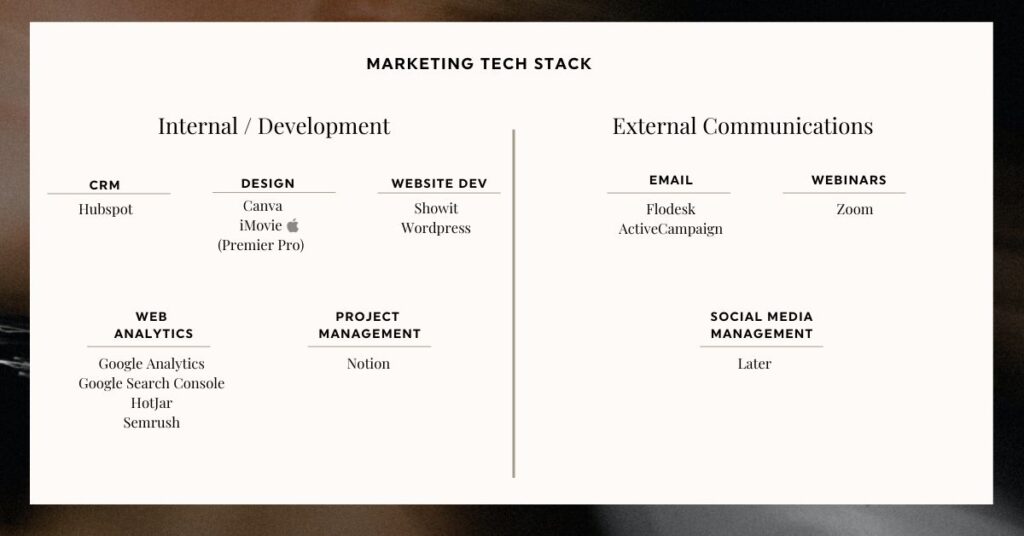There are so marketing tools to consider in the early phases of a startup. What is the best marketing tech stack for startups? What blends efficiency and ease? No one has the time for the trial and error, and please, we’ve had our fair share of YouTube tutorials.
Thankfully, we’ve tested them all so you don’t have to, and have come to a (relatively) succinct list of those that we feel confident in recommending – the ones that we hand to a founder and marketing team and know they’ll do well. These are the tools that we come back to time and time again, and ones that transcend industry or company type. There will always be variables here and some of your tools will depend on your marketing plan, but here are the ones we know you’ll need.
Here is our criteria:
1. Ease / ‘Intuitiveness’: User experience needs to be excellent. We don’t have time to learn each tool and watch tutorial after tutorial. Instead, it just needs to make sense. The buttons need to be where we expect them, ‘right click’ needs to always be available, we need to easily find our last draft. Crucially, can someone new easily be onboarded? Reasonable asks, right?
2. Cost: We’re big fans of ‘free’, but there are times when the paid version is worth it and ‘cost effective’ becomes the newly accepted criteria. In this case, we always have a close eye on the cost of new members, preparing for future growth.
- ‘Freemium’ is a popular model for all or most of the recommended tools – anything I’ve marked with ‘$/£’ notes where we believe the paid version is worth it
3. Scalability & flexibility: On that ever-optimistic note, we’re always looking for the tools that can scale with the company. While we don’t need certain features now, could we add them in future? It’s worth it to invest in tools that have the long-term feasibility.
Here’s the best marketing tech stack for startups:

Internal set-up/development
CRM:
- Hubspot ($/£)
- A one-stop, marketing-centric shop that combines all elements of the customer journey, from marketing through to sales, customer experience, etc. It really does help implement a common language across the functions/teams.
Web development:
- Showit ($/£)
- Showit is best for service-based businesses or those with focused and contained product lines. Though, shopify and e-commerce plug-ins can all be integrated. We like it because it scores high on ‘ease’ and the flexibility is always there, whether you want to edit copy, change a layout or add a new page. It’s all at your fingertips with drag and design functionality that actually works.
- If you’re looking for some great Showit templates, I always recommend Tonic.
- WordPress ($/£)
- What half the internet is built on. You’ll find most web developers are happiest with WordPress. While it all depends on the site structure, Google tends to like the ‘crawlability’ of WordPress websites, which is so small detail.
Design:
- Canva ($/£)
- As a non-designer, this is the most intuitive design programme around. This is what you want to use for ease and consistency of your content, from social media or email graphics, presentations (alt to this is Keynote for mac users, unless you have to collaboratively design), anything visual. The Canva UX team gets some credit here – it’s all incredibly intuitive. (Only ask, fix the file storage? Merci.)
- Again with a not sponsored plug for Tonic – they do some great Canva templates.
- Advanced option: InDesign ($/£)
- As a non-designer, this is the most intuitive design programme around. This is what you want to use for ease and consistency of your content, from social media or email graphics, presentations (alt to this is Keynote for mac users, unless you have to collaboratively design), anything visual. The Canva UX team gets some credit here – it’s all incredibly intuitive. (Only ask, fix the file storage? Merci.)
- iMovie
- While Canva can also do simple video editing, more intense video development is best done within iMovie.
- Advanced option: Premier Pro ($/£)
- Though, as designers would only use InDesign, Premier Pro is the more advanced tool if skillset allows.
Web analytics:
- Google Analytics
- An essential tool to track any activity on your website. From tracking traffic sources, monitoring bounce rate and setting up conversions, it’s the source of truth for website performance.
- Google Search Console
- This is all about SEO (search engine optimisation) and SERP (search engine ranking position). Here you can track how you rank on your priority keywords, compare it
- Semrush ($/£)
- This gives you that next level of insight for your SEO, and it really is worth it. You can track yourself and your competitors against your priority keywords. It’s great for social listening and informs your keywords strategy.
- Hotjar ($/£)
- A layer that Google Analytics doesn’t give you – Hot Jar show you how a user interacts with your website through ‘heat maps’ and tracks their behaviour throughout Where do they spend more time? What do they interact with? Where do they go from the homepage? It’s a great level of insight.
Project Management:
- Notion
- Despite my best efforts, I have yet to find a ClickUp, or Monday.com, or Asana that I actually like and stick to. I have good intentions, but I find it such an additional task to come in and update the project management tool. So I’ve turned to Notion as it feels more integrated – it’s where things are stored (or linked to), where I’ve taken notes, etc. I’ve learned it’s a ‘collection of databases’ that once linked/edited with proper views, is really quite useful. But it’s a controversial one! Some people love it, some people hate it. Ultimately, I like that the process and the tracking of the task is within the same tool, so while it’s not perfect, it has my vote.
External Communication
Email:
- Flodesk ($/£)
- I’m a big fan of Flodesk – it is easy to use and very design-forward. You can customise it however needed without pulling your hair out. What more can we ask for? Also, building the email automation (the ‘workflows’) is as straightforward as it gets.
- It’s also one of the few that don’t charge you based on the size of your audience. A flat rate comes with unlimited audience size and unlimited emails sent.
- You can get 50% off an annual membership
- ActiveCampaign
- My runner-up is ActiveCampaign, but for very different reasons. ActiveCampaign excels in its automation – they have over 200 different series or ‘recipes’ as they call them, of email journeys. It’s all very laid out for you, but, email customisation is more of a headache.
Social media management (organic):
- Later
- They’re partners with a lot of the key players and you can manage all social within one view, from Instagram, Facebook, TikTok, LinkedIn, etc. You can organise by content pillars, auto-post at best performing times and more. A lot of these social media schedulers are interchangeable, but I’ve found Later to be the most intuitive and ‘glitch-free’.
Webinars:
- Zoom
- If you’re building a community or doing B2B marketing, you’re likely to be doing some webinars. Depending on the audience and objective, IG or TikTok lives could replace this, but if you’re going old-school, (necessary, sometimes!), stick with what people know and use Zoom.
So there we have it – our view on the best marketing tech stack for startups. What do you think? Are there ‘must-haves’ in your world? I’d love to hear them, so leave a comment below!
See also: Resources

+ show Comments
- Hide Comments
COMMENT